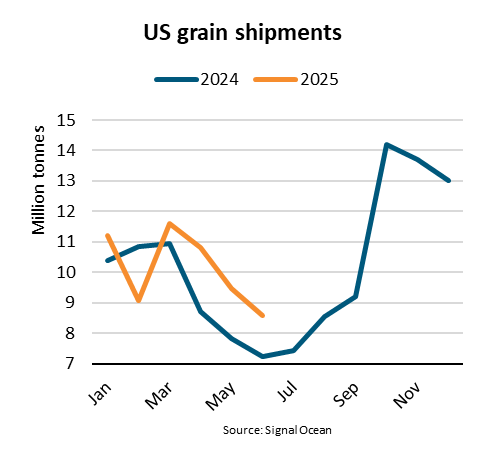BIMCO Shipping Number of the week: US grain shipments jump 9% despite Chinese tariffs

“During the first half of 2025, US seaborne grain shipments increased 9% y/y, driven by stronger maize exports. While an increase in import tariffs led to a 57% y/y drop in volumes to China, the US has been able to find alternative markets for most of its cargoes,” says Filipe Gouveia, Shipping Analysis Manager at BIMCO.
In March 2025, China introduced higher tariffs on US grain shipments, significantly reducing the competitiveness of US cargoes. As a result, the share of US grain cargoes destined for China plunged from 26% in the first half of 2024 to just 10% in 2025. To compensate for the decline, the US increased shipments to other markets in Asia, Latin America and the Mediterranean.
Still, the shift in markets did not fully offset losses in certain commodities. US soya bean exports fell 10% y/y and sorghum exports 89% y/y, as China remains a dominant player in these trades. Notably, 67% of global soya bean shipments and 84% of sorghum shipments are destined for China. By contrast, China accounts for a much smaller share of global wheat (7%) and maize (5%) shipments.
“While the increase in volume was a positive for the dry bulk sector during the first half of 2025, tonne mile demand still fell 7% y/y, due to a 14% decrease in average sailing distances. The new destinations for US grains are on average closer to the US than China. Additionally, the recovery of US grain shipments via the Panama Canal further shortened distances,” says Gouveia.
So far this year, 46% of US grain cargoes have been transported by panamax ships, 32% by supramax ships, and 22% by handysize ships. Tonne mile demand increased for the panamax and handysize segments, supported by rising cargo volumes. However, the supramax segment saw a 33% y/y decline in tonne mile demand, as it faced stiff competition from panamax vessels in key markets like Japan and China, the two largest importers of US grains.
In the coming months, the US will be entering the harvesting season for grains. The United States Department of Agriculture (USDA) projects a 6% increase in maize production, while wheat and soya bean production are expected to see marginal declines.
“A seasonal uptick in grain shipments is expected over the rest of the year following the US harvests. Tighter global supplies of wheat and maize could help sustain shipments. However, finding alternative markets for soya beans and sorghum may remain a challenge. For soya beans, in particular, China is expected to continue favouring Brazilian cargoes, bolstered by Brazil’s growing production,” says Gouveia.

This article was written by Filipe Gouveia, Shipping Analysis Manager, BIMCO
![]()
The post BIMCO Shipping Number of the week: US grain shipments jump 9% despite Chinese tariffs appeared first on Container News.
Content Original Link:
" target="_blank">

































































